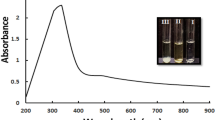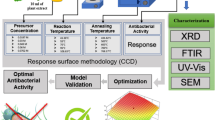Abstract
Inorganic nanomaterials with antibacterial and photocatalytic properties have gained considerable attention according to potential for biomedical and environmental applications. The aim of the present study was to prepare silver and zinc doped copper oxide nanoparticles with maximum antibacterial and photocatalytic activity. Response surface methodology using Box–Behnken design was employed for optimizing a sol-gel method according to Ag and Zn content and calcination temperature of the nanomaterials. Time-kill profiles against S. aureus and E. coli and photocatalytic degradation of methylene blue under UV-C irradiation were determined for the fifteen synthesized materials; and copper oxide nanoparticles containing 2% w/w silver and zinc atoms and calcined at 375 °C were found as the optimum material. XRD, SEM-EDX and TEM analyses showed formation of monoclinic phase of copper oxide nanoparticles with approximate diameter of 50 nm. They showed fast and efficient antibacterial and photocatalytic activity, resulted from a synergistic effect between their inorganic constituents.

Graphical abstract
Highlights
-
Sol–gel synthesis method was applied for synthesis of Ag and Zn-doped CuO nanoparticles.
-
Sol–gel method was optimized according to ratio of precursors and calcination temperature.
-
Ag–Zn-doped CuO NPs were characterized using XRD, SED-EDX, TEM and DRS.
-
Obtained Ag–Zn-doped CuO NPs showed potent antibacterial and photocatalytic activity.







Similar content being viewed by others
References
Emami-Karvani Z, Chehrazi P (2011) Antibacterial activity of ZnO nanoparticle on gram-positive and gram-negative bacteria. Afr J Microbiol Res 5:1368–1373
Pourmoslemi S, Seif F, Mahjub R (2020) Enhanced antibacterial activity of Ag-doped ZnS nanoparticles synthesised by a microwave-assisted polyol method, Mater Res Innov 1–5
Pourmoslemi S, Mohammadi A, Kobarfard F, Amini M (2016) Photocatalytic removal of doxycycline from aqueous solution using ZnO nano-particles: a comparison between UV-C and visible light. Water Sci Technol 74:1658–1670
Gong P, Li H, He X, Wang K, Hu J, Tan W, Zhang S, Yang X (2007) Preparation and antibacterial activity of Fe3O4-Ag nanoparticles. Nanotechnology 18:285604
Bensalem A, Kucukosman OK, Raszkiewicz J, Topkaya F (2021) Synthesis, characterization, bactericidal activity, and mechanical properties of hydroxyapatite nano powders impregnated with silver and zinc oxide nanoparticles (Ag-ZnO-Hap). Ceram Int 47:21319–21324
Pinatti IM, Tello AC, Trench AB, de Foggi CC, Pereira PF, Teixeira MM, Jacomaci N, Andrés J, Longo E (2020) Zinc-substituted Ag2CrO4: A material with enhanced photocatalytic and biological activity. J Alloy Compd 835:155315
Ren G, Hu D, Cheng EW, Vargas-Reus MA, Reip P, Allaker RP (2009) Characterisation of copper oxide nanoparticles for antimicrobial applications. Int J Antimicrob Ag 33:587–590
Kumar S, Mamatha G, Muralidhara H, Anantha M, Yallappa S, Hungund B, Kumar KY (2017) Highly efficient multipurpose graphene oxide embedded with copper oxide nanohybrid for electrochemical sensors and biomedical applications. J Sci Adv Mater Dev 2:493–500
Grigore ME, Biscu ER, Holban AM, Gestal MC, Grumezescu AM (2016) Methods of synthesis, properties and biomedical applications of CuO nanoparticles. Pharmaceuticals 9:75
Barabadi H, Honary S, Ebrahimi P, Alizadeh A, Naghibi F, Saravanan M (2019) Optimization of myco-synthesized silver nanoparticles by response surface methodology employing Box-Behnken design. Inorg Nano-Met Chem 49(2):33–43
Erwin SC, Zu L, Haftel MI, Efros AL, Kennedy TA, Norris DJ (2005) Do** semiconductor nanocrystals. Nature 436:91–94
Pourmoslemi S, Mohammadi A, Kobarfard F, Assi N (2016) Photocatalytic removal of two antibiotic compounds from aqueous solutions using ZnO nanoparticles. Desalin Water Treat 57:14774–14784
Desiati RD, Taspika M, Sugiarti E (2019) Effect of calcination temperature on the antibacterial activity of TiO2/Ag nanocomposite. Mater Res Express 6:095059
Liu G, Zhao Y, Sun C, Li F, Lu GQ, Cheng HM (2008) Synergistic effects of B/N do** on the visible‐light photocatalytic activity of mesoporous TiO2. Angew Chem, Int Ed Engl 47:4516–4520
Subramanian V, Wolf EE, Kamat PV (2004) Catalysis with TiO2/gold nanocomposites. Effect of metal particle size on the Fermi level equilibration. J A Chem Soc 126:4943–4950
Roguai S, Djelloul A (2021) A simple synthesis of CuO NPs for photocatalytic applications and theirs structural and optical properties. N. Technol Mater 11:53–57
Chen JC, Chen WC, Tien YC, Shih CJ (2010) Effect of calcination temperature on the crystallite growth of cerium oxide nano-powders prepared by the co-precipitation process. J Alloy Compd 496:364–369
Baiju K, Sibu C, Rajesh K, Pillai PK, Mukundan P, Warrier K, Wunderlich W (2005) An aqueous sol–gel route to synthesize nanosized lanthana -doped titania having an increased anatase phase stability for photocatalytic application. Mater Chem Phys 90:123–127
Yulizar Y, Bakri R, Apriandanu DOB, Hidayat T (2018) ZnO/CuO nanocomposite prepared in one-pot green synthesis using seed bark extract of Theobroma cacao. Nano-Struct Nano-Objects 16:300–305
Khosravi-Gandomani S, Yousefi R, Jamali-Sheini F, Huang NM (2014) Optical and electrical properties of p-type Ag-doped ZnO nanostructures. Ceram Int 40:7957–7963
Kumar P, Mathpal MC, Prakash J, Viljoen BC, Roos W, Swart H (2020) Band gap tailoring of cauliflower-shaped CuO nanostructures by Zn do** for antibacterial applications. J Alloy Compd 832:154968
Iqbal T, Ara G, Khalid N, Ijaz M (2020) Simple synthesis of Ag-doped CdS nanostructure material with excellent properties. Appl Nanosci 10:23–28
Kukushkina EA, Hossain SI, Sportelli MC, Ditaranto N, Picca RA, Cioffi N (2021) Ag-based synergistic antimicrobial composites. A critical review. Nanomaterials 11:1687
Eshed M, Lellouche J, Gedanken A, Banin E (2014) A Zn‐doped CuO nanocomposite shows enhanced antibiofilm and antibacterial activities against streptococcus mutans compared to nanosized CuO. Adv Funct Mater 24:1382–1390
Mohammadi A, Pourmoslemi S (2018) Enhanced photocatalytic degradation of doxycycline using a magnetic polymer-ZnO composite. Water Sci Technol 2017:791–801
Wu MC, Lin TH, Hsu KH, Hsu JF (2019) Photo-induced disinfection property and photocatalytic activity based on the synergistic catalytic technique of Ag doped TiO2 nanofibers. Appl Surf Sci 484:326–334
Author contributions
All authors contributed to the study conception and design. Material preparation, data collection and analysis were performed by SP, RM and NB. The first draft of the manuscript was written by SP and all authors commented on previous versions of the manuscript. All authors read and approved the final manuscript.
Funding
This work was supported by Vice-chancellor for Research and Technology, Hamadan University of Medical Sciences, under [grant number 9704192144].
Author information
Authors and Affiliations
Corresponding author
Ethics declarations
Conflict of interest
The authors declare no competing interests.
Additional information
Publisher’s note Springer Nature remains neutral with regard to jurisdictional claims in published maps and institutional affiliations.
Rights and permissions
Springer Nature or its licensor holds exclusive rights to this article under a publishing agreement with the author(s) or other rightsholder(s); author self-archiving of the accepted manuscript version of this article is solely governed by the terms of such publishing agreement and applicable law.
About this article
Cite this article
Pourmoslemi, S., Bayati, N. & Mahjub, R. Application of Box–Behnken design to optimize a sol-gel synthesis method for Ag and Zn doped CuO nanoparticles with antibacterial and photocatalytic activity. J Sol-Gel Sci Technol 104, 319–329 (2022). https://doi.org/10.1007/s10971-022-05946-2
Received:
Accepted:
Published:
Issue Date:
DOI: https://doi.org/10.1007/s10971-022-05946-2




